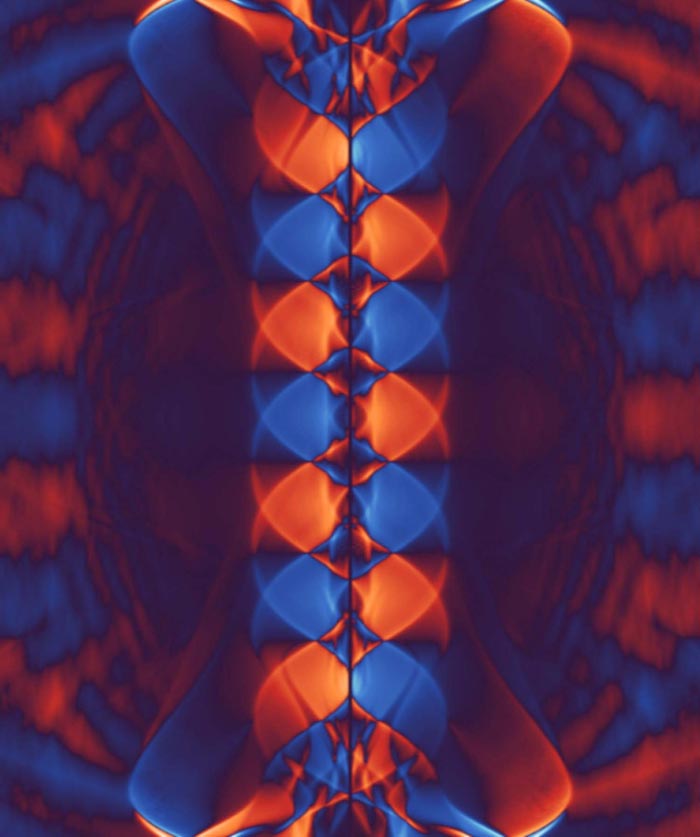A necklace of fractional vortices

A route to a time-reversal symmetry-broken state for d-wave superconductors is shown to occur via the formation of a necklace of fractional vortices around the perimeter of the material, where neighboring vortices have opposite current circulation. This vortex pattern is a result of a spectral rearrangement of current-carrying states near the edges. Credit: Mikael Håkansson
“Symmetries are an important aspect when describing nature”, says Mikael Fogelström, who is a professor of theoretical physics at Chalmers University of Technology.
“A ball is round and looks the same regardless of how we rotate it; thus, it has rotational symmetry. In the same way, most materials have symmetries that describe what the materials look like and what their properties are. If one or more symmetries breaks, this signals a phase transition to a new state. When a material becomes magnetic, a more abstract symmetry, what is known as time-reversal symmetry, is broken”.
Superconducting materials conduct electric current without loss of energy. In 1986, researchers discovered that a family of perovskite materials – that have two-dimensional copper-oxide planes – becomes superconductive at relatively high temperatures. It could also thereafter be fairly quickly ascertained by experiments that the superconducting phase also broke the crystal symmetry, and that the material was unusual in this respect.
Theoreticians pondered whether the materials could also break time-reversal symmetry and produce spontaneous magnetisation. Experiments, primarily related to electron transport, showed that this was the case, while another category of experiments aimed at directly measuring the spontaneous magnetisation demonstrated no effect.
“Our work has arrived at a new mechanism for breaking time-reversal symmetry in high-temperature superconductors” says Tomas Löfwander, who is one of the researchers behind the new results. “We maintain that this has probably already been observed and that the two sets of experiments do not contradict one another.”
The Chalmers researchers' discovery is based on a software package that researcher Mikael Håkansson developed while completing his licentiate thesis at the Division of Applied Quantum Physics at MC2, in order to produce a theoretical model of small mesoscopic superconducting grains. The software package utilises massive parallelisation of the numeric work, which can then be processed in graphics processing units, or GPUs.
“The time required to perform the fairly demanding computations was significantly reduced, and we were able to focus more on the physics and simulate more realistic systems”, explains Mikael Håkansson. “At the same time, I developed a tool to process and visualise the large amounts of data that the software produced. The cover of the September issue of Nature Physics shows how the electron state is distributed in energy along a surface of a high-temperature superconductor when it has broken the time-reversal symmetry.”
The computational tool has allowed the Chalmers researchers to investigate cases where the ring of a superconducting crystal affects the force of the superconducting phase. A periodic pattern of vortices spontaneously forms in the shape of a necklace along the surface as soon as the temperature is lower than a limit temperature. These vortices in turn cause a spontaneous magnetic flux that alternates direction on a length scale of a few dozen nanometers.
“We believe that new results with what are known as nanosquids, which are magnetometers with extremely good resolution, will be able to give immediate experimental verification of our results,” says Mikael Fogelström.
###
Read the article “Spontaneously broken time-reversal symmetry in high-temperature superconductors” in Nature Physics: http://dx.
Media Contact
All latest news from the category: Materials Sciences
Materials management deals with the research, development, manufacturing and processing of raw and industrial materials. Key aspects here are biological and medical issues, which play an increasingly important role in this field.
innovations-report offers in-depth articles related to the development and application of materials and the structure and properties of new materials.
Newest articles

A ‘language’ for ML models to predict nanopore properties
A large number of 2D materials like graphene can have nanopores – small holes formed by missing atoms through which foreign substances can pass. The properties of these nanopores dictate many…

Clinically validated, wearable ultrasound patch
… for continuous blood pressure monitoring. A team of researchers at the University of California San Diego has developed a new and improved wearable ultrasound patch for continuous and noninvasive…

A new puzzle piece for string theory research
Dr. Ksenia Fedosova from the Cluster of Excellence Mathematics Münster, along with an international research team, has proven a conjecture in string theory that physicists had proposed regarding certain equations….



